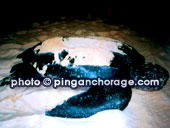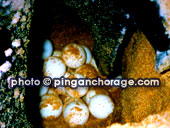|
Turtle
Turtles has
appeared on earth for more than 100 million years, to the age of
dinosaurs, with the different that these living dinosaurs are still
surviving through the decades, despite that environment on earth has
been changing throughout the this period. Studies reports show that
it is possible for a turtle to live for hundreds years of time, and
this explains why the Chinese society treats turtles as a symbol of
longevity.
Turtles are
categorized according to its physical appearance, behaviors and
nesting site. To your surprise, sex of hatchings is determined by
the temperature of the surrounding sand, which a female turtle lays
its eggs. A warm nest will result in mostly female hatchings while
males are mostly come from a cooler nest.
There are seven
recognized species of sea turtle in the world, which are divided
into two families, Dermochelydae and Cheloniidae. The only species
that is categorized in the Dermochelydae family is the Leatherback
turtle The rest six species, i.e. Green turtle, Olive Ridley turtle,
Hawksbill turtle, Loggerhead, Kemp’s Ridley turtle and Flatback
turtle are all belong to the Cheloniidae family. Among these seven
species, four choose to nest in Malaysia beaches.
|
Leatherback turtle (Dermochelys
coriacea)
The name Leatherback
turtle derives from its smooth leathery carapace or shell. Because of
its star fruit-like leathery soft shell, the locals also call
Leatherback‘Penyu Belimbing’. An adult Leatherback can reach a length of
2 meters and weigh up to 900 kg. It is the largest turtle in the world.
Although leatherback
breeds in the tropics, they spend much of their life foraging in very
cold seas. Their body temperature raises several degrees above that of
their environment. The powerful front flippers of these turtles enable
them to swim for a long periods of time in the sea. They regularly dive
to depth of over 400 meters with a recorded maximum depth of 1200
meters. Leatherbacks are excellent swimmers and divers, indeed.
In Malaysia,
Leatherback nests only in beaches in Terengganu with Rantau Abang famous
to be the major nesting concentration. |

Leatherback Turtle

Turtle lay eggs |
Green turtle (Chelonia
mydas)
Green turtle or
Penyu agar is called by this name because of its greenish soft body
and jelly like substance. Unfortunately this special feature has
also made them a very popular food in some restaurants. Green
turtles are carnivorous in the first few days of their lives and
subsequently become herbivorous. They feed on seaweeds and algae. An
adult Green turtle can reach the length of 110cm and weight of
150kg. Female Green turtles can lay 140 eggs per nesting and each
takes 50-70 days for incubation.
To date, Green
turtles are among the most widely spread turtles in Malaysia waters
with the nesting site can be found in Pulau Redang Pulau Perhentian
and Cherating in east coast, Pantai Remis in west coast of
Peninsular Malaysia and some other beaches in west Malaysia.
Hawksbill turtle (Eretmochelys
imbricata)
The Hawksbill
turtle or Penyu Karah derives it names from the hawk-like beak.
Hawksbill turtle has hard attractive dark brown shell or shell with
yellow and brown overlapping scales. This beautiful shell makes
Hawksbill turtle a hunting target for the tortoise-shell jewelry
trading which lead them to endangering. Adult Hawksbill has a
carapace of 70-90cm and weighted up to 60kg.
Beaches in Pulau
Gulisaan of Sabah is the major nesting site of Hawksbill turtle
found in South East Asian region. However, this beautiful turtle can
also been found in Pulau Redang of Terengganu.
Olive Ridley
turtle (Lepidochelys olivacea)
Another species,
which is found in Malaysia waters is the Olive Ridley turtle. Olive
Ridley turtle is the smallest of all the turtle found in the world
where an adult Olive Ridley is only 60-65cm in length and 35-40kg in
weight. It is also called Penyu Lipas by the locals. Just like the
name implies, Olive Ridley turtle has olive-green or gray colour
shell. This turtle feeds mainly on shrimps, jellyfish, crabs and
snails.
Although nesting of
Olive Ridley in Malaysia is not concentrated and sparse, some
nesting can still be found in Pulau Redang and beaches in Kelantan.
|
77A, Jalan Sultan Sulaiman, 20000 Kuala
Terengganu, Terengganu, Malaysia.
Tel : +609 6262020 Fax : +609 6262022 / +609 6228093
E-mail Us
COPYRIGHT © PERHENTIAN-ISLAND.COM . ALL RIGHTS RESERVED .
(License : KPL/LN2117 / 209874W) |
|